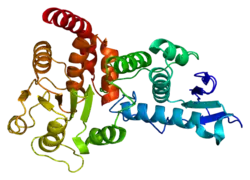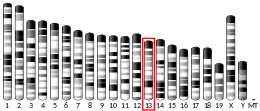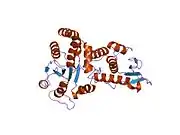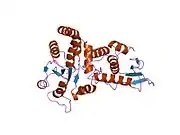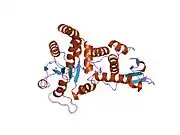Dual specificity protein phosphatase CDC14B is an enzyme that in humans is encoded by the CDC14B gene.[5][6]
The protein encoded by this gene is a member of the dual specificity protein tyrosine phosphatase family. This protein is highly similar to Saccharomyces cerevisiae Cdc14, a protein tyrosine phosphatase involved in the exit of cell mitosis and initiation of DNA replication, which suggests the role in cell cycle control. Specifically, it is thought to fulfil this role by bundling and stabilising microtubules. This protein has been shown to interact with and dephosphorylates tumor suppressor protein p53, and is thought to regulate the function of p53. Alternative splicing of this gene results in 3 transcript variants encoding distinct isoforms.[6]
Interactions and Functions
CDC14B has been shown to interact with p53, potentially de-phosphorylate p53 at Serine 315 and thereby stabilize p53.[7] S315-phosphorylated p53, in contrast to other p53 phosphorylation, was shown to facilitate p53 degradation.[8] At the patho-physiological level, mice with CDC14B deletion were shown to exhibit early-onset ageing phenotypes. [9]
References
- 1 2 3 GRCh38: Ensembl release 89: ENSG00000081377 - Ensembl, May 2017
- 1 2 3 GRCm38: Ensembl release 89: ENSMUSG00000033102 - Ensembl, May 2017
- ↑ "Human PubMed Reference:". National Center for Biotechnology Information, U.S. National Library of Medicine.
- ↑ "Mouse PubMed Reference:". National Center for Biotechnology Information, U.S. National Library of Medicine.
- ↑ Li L, Ernsting BR, Wishart MJ, Lohse DL, Dixon JE (November 1997). "A family of putative tumor suppressors is structurally and functionally conserved in humans and yeast". The Journal of Biological Chemistry. 272 (47): 29403–29406. doi:10.1074/jbc.272.47.29403. PMID 9367992.
- 1 2 "Entrez Gene: CDC14B CDC14 cell division cycle 14 homolog B (S. cerevisiae)".
- ↑ Li L, Ljungman M, Dixon JE (January 2000). "The human Cdc14 phosphatases interact with and dephosphorylate the tumor suppressor protein p53". The Journal of Biological Chemistry. 275 (4): 2410–2414. doi:10.1074/jbc.275.4.2410. PMID 10644693.
- ↑ Li, Y; Cui K; Zhang Q; Li X; Lin X; Tang Y; Prochownik E; Li Y (July 2021). "FBXL6 degrades phosphorylated p53 to promote tumor growth". Cell Death Differ. 28 (7): 2112–2125. doi:10.1038/s41418-021-00739-6. ISSN 1350-9047. PMC 8257708. PMID 33568778.
- ↑ Wei Z, Peddibhotla S, Lin H, Fang X, Li M, Rosen M, Zhang P (April 2011). "Early-onset aging and defective DNA damage response in Cdc14b-deficient mice". Mol. Cell. Biol. 31 (7): 1470–1477. doi:10.1128/MCB.01330-10. PMC 3135283. PMID 21262768.
Further reading
- Maruyama K, Sugano S (January 1994). "Oligo-capping: a simple method to replace the cap structure of eukaryotic mRNAs with oligoribonucleotides". Gene. 138 (1–2): 171–174. doi:10.1016/0378-1119(94)90802-8. PMID 8125298.
- Suzuki Y, Yoshitomo-Nakagawa K, Maruyama K, Suyama A, Sugano S (October 1997). "Construction and characterization of a full length-enriched and a 5'-end-enriched cDNA library". Gene. 200 (1–2): 149–156. doi:10.1016/S0378-1119(97)00411-3. PMID 9373149.
- Li L, Ljungman M, Dixon JE (January 2000). "The human Cdc14 phosphatases interact with and dephosphorylate the tumor suppressor protein p53". The Journal of Biological Chemistry. 275 (4): 2410–2414. doi:10.1074/jbc.275.4.2410. PMID 10644693.
- Mailand N, Lukas C, Kaiser BK, Jackson PK, Bartek J, Lukas J (April 2002). "Deregulated human Cdc14A phosphatase disrupts centrosome separation and chromosome segregation". Nature Cell Biology. 4 (4): 317–322. doi:10.1038/ncb777. PMID 11901424. S2CID 28955777.
- Kaiser BK, Zimmerman ZA, Charbonneau H, Jackson PK (July 2002). "Disruption of centrosome structure, chromosome segregation, and cytokinesis by misexpression of human Cdc14A phosphatase". Molecular Biology of the Cell. 13 (7): 2289–2300. doi:10.1091/mbc.01-11-0535. PMC 117313. PMID 12134069.
- Dryden SC, Nahhas FA, Nowak JE, Goustin AS, Tainsky MA (May 2003). "Role for human SIRT2 NAD-dependent deacetylase activity in control of mitotic exit in the cell cycle". Molecular and Cellular Biology. 23 (9): 3173–3185. doi:10.1128/MCB.23.9.3173-3185.2003. PMC 153197. PMID 12697818.
- Gray CH, Good VM, Tonks NK, Barford D (July 2003). "The structure of the cell cycle protein Cdc14 reveals a proline-directed protein phosphatase". The EMBO Journal. 22 (14): 3524–3535. doi:10.1093/emboj/cdg348. PMC 165618. PMID 12853468.
- Nalepa G, Harper JW (October 2004). "Visualization of a highly organized intranuclear network of filaments in living mammalian cells". Cell Motility and the Cytoskeleton. 59 (2): 94–108. doi:10.1002/cm.20023. PMID 15362113.
- Cho HP, Liu Y, Gomez M, Dunlap J, Tyers M, Wang Y (June 2005). "The dual-specificity phosphatase CDC14B bundles and stabilizes microtubules". Molecular and Cellular Biology. 25 (11): 4541–4551. doi:10.1128/MCB.25.11.4541-4551.2005. PMC 1140622. PMID 15899858.
- Vázquez-Novelle MD, Esteban V, Bueno A, Sacristán MP (August 2005). "Functional homology among human and fission yeast Cdc14 phosphatases". The Journal of Biological Chemistry. 280 (32): 29144–29150. doi:10.1074/jbc.M413328200. PMID 15911625.
External links
- Human CDC14B genome location and CDC14B gene details page in the UCSC Genome Browser.
